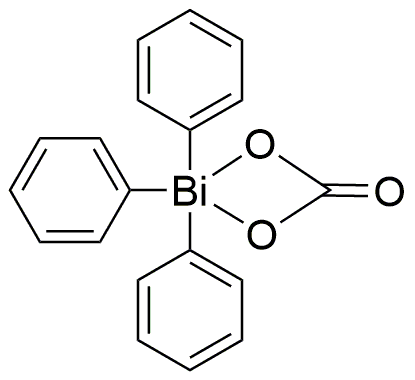Triphenylbismuth carbonate is widely utilized in research focused on:
- Pharmaceutical Development: This compound serves as a precursor in the synthesis of bismuth-based drugs, which are effective in treating gastrointestinal disorders, providing an alternative to traditional therapies.
- Catalysis: It acts as a catalyst in various organic reactions, enhancing reaction rates and selectivity, making it valuable in the production of fine chemicals and pharmaceuticals.
- Material Science: Used in the development of advanced materials, it contributes to the creation of high-performance polymers and composites, which are essential in aerospace and automotive industries.
- Environmental Applications: Its properties allow for the remediation of heavy metal contamination in soils and water, offering a safer method for environmental cleanup compared to conventional methods.
- Research in Coordination Chemistry: This compound is a subject of study for its unique coordination properties, aiding researchers in understanding complex chemical interactions and developing new materials with tailored properties.
General Information
Properties
Safety and Regulations
Applications
Triphenylbismuth carbonate is widely utilized in research focused on:
- Pharmaceutical Development: This compound serves as a precursor in the synthesis of bismuth-based drugs, which are effective in treating gastrointestinal disorders, providing an alternative to traditional therapies.
- Catalysis: It acts as a catalyst in various organic reactions, enhancing reaction rates and selectivity, making it valuable in the production of fine chemicals and pharmaceuticals.
- Material Science: Used in the development of advanced materials, it contributes to the creation of high-performance polymers and composites, which are essential in aerospace and automotive industries.
- Environmental Applications: Its properties allow for the remediation of heavy metal contamination in soils and water, offering a safer method for environmental cleanup compared to conventional methods.
- Research in Coordination Chemistry: This compound is a subject of study for its unique coordination properties, aiding researchers in understanding complex chemical interactions and developing new materials with tailored properties.
Documents
Safety Data Sheets (SDS)
The SDS provides comprehensive safety information on handling, storage, and disposal of the product.
Product Specification (PS)
The PS provides a comprehensive breakdown of the product’s properties, including chemical composition, physical state, purity, and storage requirements. It also details acceptable quality ranges and the product's intended applications.
Certificates of Analysis (COA)
Search for Certificates of Analysis (COA) by entering the products Lot Number. Lot and Batch Numbers can be found on a product’s label following the words ‘Lot’ or ‘Batch’.
Número de catálogo
Número de lote/lote
Certificates Of Origin (COO)
This COO confirms the country where the product was manufactured, and also details the materials and components used in it and whether it is derived from natural, synthetic, or other specific sources. This certificate may be required for customs, trade, and regulatory compliance.
Número de catálogo
Número de lote/lote
Safety Data Sheets (SDS)
The SDS provides comprehensive safety information on handling, storage, and disposal of the product.
DownloadProduct Specification (PS)
The PS provides a comprehensive breakdown of the product’s properties, including chemical composition, physical state, purity, and storage requirements. It also details acceptable quality ranges and the product's intended applications.
DownloadCertificates of Analysis (COA)
Search for Certificates of Analysis (COA) by entering the products Lot Number. Lot and Batch Numbers can be found on a product’s label following the words ‘Lot’ or ‘Batch’.
Número de catálogo
Número de lote/lote
Certificates Of Origin (COO)
This COO confirms the country where the product was manufactured, and also details the materials and components used in it and whether it is derived from natural, synthetic, or other specific sources. This certificate may be required for customs, trade, and regulatory compliance.


